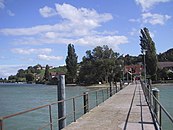Mannenbach-Salenstein
| Mannenbach-Salenstein | ||
|---|---|---|
| State : |
|
|
| Canton : |
|
|
| District : | Kreuzlingen | |
| Political community : | Salenstein | |
| Postal code : | 8268 | |
| former BFS no. : | 4852 | |
| Coordinates : | 721331 / 281612 | |
| Height : | 415 m above sea level M. | |
| Area : | 0.58 km² | |
| Residents: | 271 (December 31, 2018) | |
| Population density : | 467 inhabitants per km² | |
|
Mannenbach-Salenstein photographed from Arenenberg Castle - the jetty in the background |
||
| map | ||
|
|
||
Mannenbach-Salenstein , until around 2010 Mannenbach , is a town in the political municipality of Salenstein in the Kreuzlingen district of the canton of Thurgau in Switzerland . It is located on the south bank of the Untersee opposite the island of Reichenau .
From 1816 to 1978 the local community of Mannenbach with Fruthwilen and Salenstein formed the municipal community of Salenstein. In 1979, the three local churches united to unified community Salenstein.
history
The oldest mention of Mannenbach in an original document comes from the year 1221. The Villule Manninbach belonged to the Reichenau monastery . In the Middle Ages , Reichenau Monastery was the landlord , court lord and collator .
After financial difficulties in the monastery in the 15th century, Mannenbach was pledged several times. The residents tried to redeem the pledge themselves and thus came to a letter of freedom on June 4, 1414, in which the abbot granted them the right to determine the Ammann themselves. In the Swabian War , the village was together with the villages Triboltingen and Ermatingen sacked on 11 April 1499 by the Swabian troops and set on fire. In 1502 Mannenbach received an opening . After the abbey was incorporated into the Constance monastery in 1540, the lower court of Mannenbach with Mannenbach and Salenstein was under the control of the Bishop of Constance until 1798, who administered it from the Upper Bailiwick of Reichenau. After the upheavals of 1798, Mannenbach formed its own municipality .
Mannenbach, which was reformed by the majority from 1529, always belonged to the parish or parish of Ermatingen. The chapel of St. Aloysius (supposedly consecrated in 1155) with late medieval wall paintings was connected with a benefice and a chaplain; In 1559 it was incorporated into the Reichenau monastery. In 1835/36 the French General Marquis de Crenay built the classicist Louisenberg Castle in place of the old chaplain building .
A mill is mentioned in 1350. Viticulture lost its importance from the 19th century. Up until the middle of the 20th century, livestock, fruit growing and fishing formed the economic basis of the population. The village was connected to the Etzwilen – Konstanz railway line in 1874 . At the end of the 20th century, new residential buildings were built due to the location on the lake.
coat of arms
Blazon : In silver a red, growing bear with black armor and black collar.
Occupied in the Middle Ages. At that time, the ferrymen from Mannenbach owned the ferry rights to Reichenau. Johannes Stumpf's chronicle shows the Mannenbacher bear, which goes back to a family coat of arms.
population
| year | 1850 | 1900 | 1930 | 1950 | 1970 | 2000 | 2010 | 2018 |
| Local parish | 186 | 148 | 216 | 202 | 224 | |||
| Locality | 212 | 248 | 271 | |||||
| source | ||||||||
Of the total of 271 inhabitants in Mannenbach-Salenstein in 2018, 71 or 26.2% were foreign nationals. 110 (40.6%) were Protestant Reformed and 68 (25.1%) were Roman Catholic.
Attractions
The village of Mannenbach-Salenstein is listed in the inventory of places worth protecting in Switzerland .
The pilgrimage chapel of St. Aloysius and Louisenberg Castle are on the list of cultural assets in Salenstein . The castle, which was built in place of the old chaplain building, stands directly next to the St. Aloysius chapel.
Pilgrimage Chapel of St. Aloysius
The chapel is located at the southwest exit of Mannenbach-Salenstein on a small hill. It is oriented towards the lake, which used to be the traffic area. The chapel was consecrated in 1155 in honor of the Holy Trinity and Saints Niklaus , Dionysius and Georg . According to the legend, the founding of the chapel goes back to a knight von Salenstein, who donated it out of gratitude for the dangers of a cruise. A splinter of the holy cross was kept as the most important relic .
The Romanesque chapel was expanded to the north and east in the 1580s and provided with painting cycles. The Reichenau Monastery was the collator of the chapel until 1540 . The high medieval chapel lost its importance due to the Reformation and was devastated with its altars . In 1692 the chapel and the associated pilgrimage were revived and St. Aloysius was venerated. In 1694/95 the late Gothic chapel was restored and a new ceiling was put in. The chapel was last restored between 1993 and 1995.
Transport and tourism
The Swiss National Railway opened on July 17, 1875, on the Etzwilen – Konstanz / Kreuzlingen Hafen railway line . Mannenbach was thus connected to the rail network. In the specialist literature it is assumed that the station building Mannenbach-Salenstein served as a model for the uniform station in Württemberg .
In summer Mannenbach can be reached by scheduled boat on the Schaffhausen – Kreuzlingen line operated by the Swiss Untersee and Rhine shipping company . A special attraction is the solar ferry that connects Mannenbach with the opposite island of Reichenau in the summer months.
Personalities
- Ferdinand Hardekopf (1876–1954), German writer, lived in Mannenbach and Salenstein around 1912
- Susie Stoddart (* 1982), Scottish racing car driver (DTM), has lived in Mannenbach-Salenstein since 2008
photos
Mannenbach from Arenenberg Castle from a watercolor by Lorenzo Quaglio the Elder. J. , around 1856
literature
- Hans Baumgartner: Salenstein - Fruthwilen - Mannenbach. Book for the 900th anniversary 1092–1992. Frauenfeld 1992.
- Alfons Raimann, Peter Erni: The art monuments of the canton Thurgau VI. The Steckborn district. Bern 2001.
Web links
Individual evidence
- ↑ Swiss land use statistics. Completed on July 1, 1912. Published by the Federal Statistical Bureau. ( Memento from April 12, 2016 in the Internet Archive )
- ↑ a b c d Localities and their resident population. Edition 2019 . On the website of the Statistical Office of the Canton of Thurgau (Excel table; 0.1 MB), accessed on April 28, 2020.
- ↑ a b List of localities and settlements. Canton of Thurgau, 2005 edition . On the website of the Statistical Office of the Canton of Thurgau (PDF; 1.7 MB), accessed on April 28, 2020.
- ↑ a b List of localities and settlements. Canton of Thurgau, 2012 edition. On the website of the Statistical Office of the Canton of Thurgau (PDF; 3.4 MB), accessed on May 11, 2020.
- ↑ Population development of the municipalities. Canton of Thurgau, 1850-2000. On the website of the Statistical Office of the Canton of Thurgau (Excel table; 0.1 MB), accessed on April 28, 2020.
-
↑ a b c d e Verena Rothenbühler: Mannenbach. In: Historical Lexicon of Switzerland .
These sections are largely based on the entry in the Historical Lexicon of Switzerland (HLS), which, according to the HLS's usage information, is under the Creative Commons license - Attribution - Share under the same conditions 4.0 International (CC BY-SA 4.0). - ↑ a b Mannenbach coat of arms. On the website of the municipality of Salenstein, accessed on February 1, 2020
- ↑ Jürg Ganz: Pilgrimage Chapel St. Aloysius Mannenbach. (Swiss Art Guide, No. 635). Ed. Society for Swiss Art History GSK. Bern 1998, ISBN 978-3-85782-635-1 .
- ↑ Swiss rail network. Published by the SBB General Secretariat, Bern 1980, p. 23.
- ^ Albrecht Bedal: Early secondary railway and first standard station. On the history of the Kupferzell rail connection. In: The station from Kupferzell. The story of a station building in Württemberg and the Waldenburg – Künzelsau branch line. Hohenloher Freilichtmuseum, Schwäbisch Hall 2001, ISBN 3-9806793-3-0 , p. 56.














